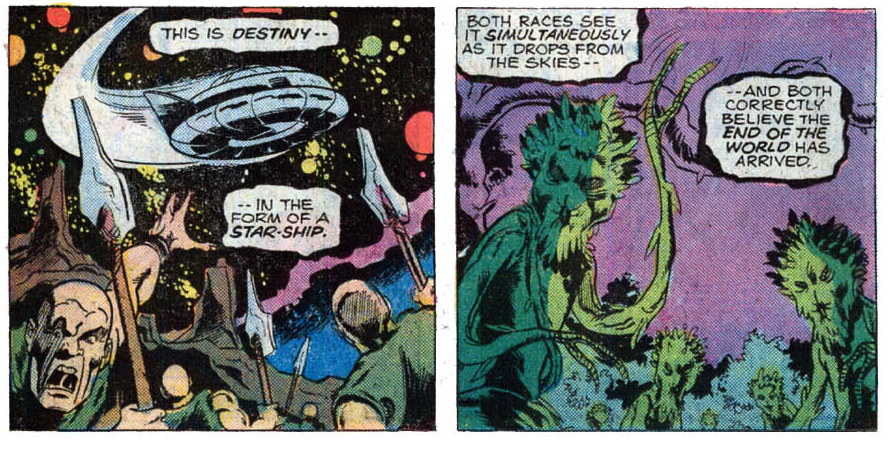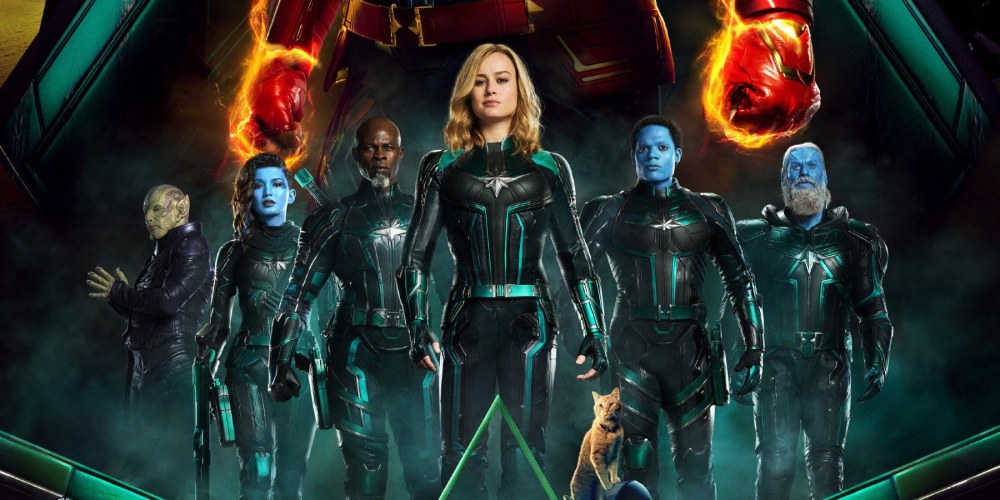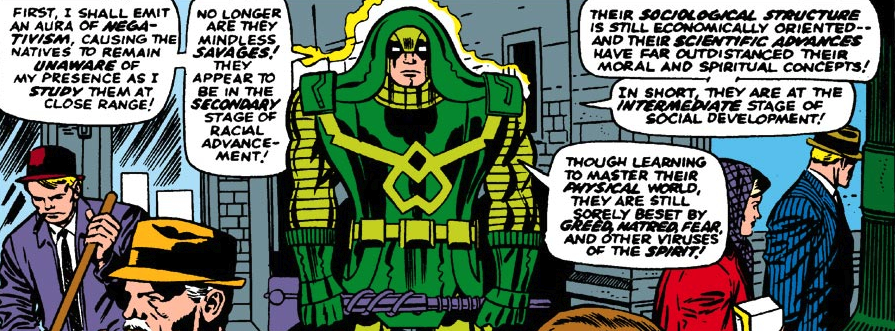In Carol Danvers early appearance she falls in love with the male Kree alien Mar Vell, while becoming an antagonist of his human persona Walter Lawson. The Kree, as mentioned, are a reference to Christians. Here is the evidence:
They are ruled by “Imperial Ministers.” The first definition of Minister is commonly “a person authorized to conduct religious worship; member of the clergy; pastor.” Of course this title by itself, since it obviously appears as a secular term as well, is unmeaningful. However combined with other details it becomes strongly corroborative of my thesis.
The Kree employ “Sentries,” indestructible robots, whom are almost certainly a reference to the Angels known as The Watchers in the Hebrew Bible. Indeed, Lee will more explicitly reference The Watchers with his Fantastic Four ally, Uatu, also known simply as “The Watcher.”

The Sentries are highly advanced, nearly indestructible robots, hence a sense of the Aryan angel as programed or controlled golem or robot is emphasized here. The Kree also deploy a figure named Ronan The Accuser who is almost certainly a reference to Satan as accuser in the Biblical works. To wit, the accuser is a title Satan assumes in multiple Biblical passages.
In the Biblical Context it should be made clear that Yahweh is understood as deploying Satan as his agent to make sure his subjects are sufficiently worshipful. This is seen especially in the book of Job as this study covers. The tormented and cowering Job is an especially Aryan figure as this study covers.
The Kree also bow to a super computer known as the “Supreme Intelligence of the majestic race of the Kree.”[1] It is a supercomputer combining all the greatest Kree minds over millions of years. Within a Christian metaphor its most obvious analog is found in Biblical scripture and the writings of the Church fathers.
One of the senses of the word “intelligence” is: “an intelligent being or spirit, especially an incorporeal one, as an angel.” As this study discusses, however, Angels in particular are best understood as servile Aryan front men for a Jewish God akin to the Kree Sentries. The Kree “Supreme Intelligence,” on the other hand, is best understood as something akin to Yahweh. This will become clearer as we discuss the Kree/Skrull conflict and color symbolism appearing in these parables.
The word “intelligence” may suggest a double meaning as in “an organization or agency engaged in gathering information on an enemy” and this may speak to a crypto-Jewish element in Christianity suggested by Lee in these parables. It may even coyly suggest the scriptures as a source of “gathered intelligence and their conclusions” on the “Kree.” After all, the word “intelligence” may also carry that meaning. This understanding of the Jewish Biblical works, where such “intelligence” is conveyed, albeit esoterically, will resonate with readers of this study.
Regardless, the more obvious premise here, certainly, is that the Christian Kree are guided by a higher Jewish intelligence. What is made clear is that this intelligence and design is mysterious to them and well beyond their fathoming. This is an uncontroversial premise every Christian admits implicitly. Indeed, Kree Technology in general, including the Sentries, is ancient technology. These old technologies are unfathomable to Christian Kree who still kneel to them worshipfully and are, actually, incapable of resisting or destroying them.

Likewise it seems almost certain the name Kree is taken from the name of the Indian Cree tribe. The meaning and etymology of Cree becomes important. “Cree” comes from the French name of the tribe “Kristenaux” meaning Christian. Possibly the name Kree is also a reference to the word “creed” which in the Christian context means “an authoritative, formulated statement of the chief articles of Christian belief, as the Apostles’ Creed, the Nicene Creed, or the Athanasian Creed.”
Possibly the phrase The Kree is a reference to the term “decree” which in theological terms means “one of the eternal purposes of God, by which events are foreordained.” This may also play to the authoritarian bearing of the law worshiping Kree. The element of “cree,” ultimately from the Latin cernere means “separate.”
Hence Lee may be indicating The Kree, if not racial separatists, racially separated or pure. Here we should remember that naming practices in JEM are typically careful and the reference to the Cree tribe is likely the primary reference here. In Avengers #133 (1975) writer Steven Englehart, under editor Len Wein, will introduce the peaceful plant like race of the Cotati amid the feuding Kree and Skrull races.
There the tendrilled, vine like Cotati, the intended inheritors of Skrull technology, are suggested as the early Jewish Christians who are aggressively supplanted by the war like Aryan Kree, who steal the Skrull technologgy. This name choice of Cotati tends to suggest an awareness at Marvel that the name Kree is, indeed, a reference to the Indian tribe of the Cree. Indeed Cotati is the name of an obscure tribe-let of the Coast Miwok Indians, likewise understood as peaceful.

Eventually the Kree reach a state of civilization comparable to that of Skrulls. Secretly some portion of the Kree have protected a remnant of the peace-loving Cotati as objects of worship. Here the metaphors are quite transparent. Indeed, here, however roughly drawn, we find a replacement theology narrative where Christians have stolen the “technology” of Jews and worship other Jews as Gods or apostles.
Color symbolism in the original Mar Vell and Carol Danver parables
When analyzing the choice of color in comic books, in particular, it is important to distinguish between colors being used in uniform or clothing and colors being used in the sometimes fantastical skin color of these mythological figures. In other words, the wearing of a color may indicate, for example, the Judaization or Semitization of a figure as opposed to a Jewish identity.
We see for example the Aryan figures of Hal Jordan, the Second Green Lantern, and Oliver Queen, Green Arrow, both wearing Green, typically a Jewish color. In their cases though, it appears to indicate a kind of Jewish possession, subservience to Judaism or, indeed, Judaization as the broader study explores. On the other hand, the wearing of a “Jewish color,” in no way, of course, excludes a hero from being indicated as Jewish. We find this with first Green Lantern, Alan Scott, and also with Stan Lee’s Mar Vell, both of whom are indicated as Jewish. In every case, additional corroborative contextual clues become important.
In the 2019 film we see the Kree, esoterically understood as Christians, wearing the “Semitic” color of Green. In the beginning, however, with introduction of Mar Vell in 1968, we see clearly costume color being used as ethnic identifier. Color symbolism in costume indicating Krees as Aryan in race or, at least, Aryan presenting will be emphasized in the Kree villain Yon Rogg from his first appearance. Yon Rogg’s blue suit will feature a white chest with a yellow or golden planet. All three colors are celestial Aryan identifiers as this study covers.
Indeed, some portion of the more “noble” Kree will actually be developed as blue-skinned under Jewish editorship. This seems to follow a pattern with the blue-skinned Oans in Kanigher’s Green Lantern parable. There, though, the Oans may symbolize the lesser, outer degrees of Freemasonry or benighted Aryans within Freemasonry more generally, as this study discusses. The Kree, in contrast, as discussed, become especially a symbol for Christianity.

The purple and blue design of the robotic Kree Sentries suggests royalty and Aryanness but also admixture. As this study discusses, purple is where an Aryan blue meets red, the color of vulnerability to admixture. This makes sense if we understand the Sentries as references to the Watchers who are indicated as higher beings descending among the daughters of man and admixing in the days leading up to the flood. Hence it becomes meaningful as well that Lee indicates Sentries descending to the earth in his Marvel parables. To wit, they are harbingers of “the flood” or racial admixture.
The Kree will be contrasted with and pitted against the Green-skinned Skrulls, particularly in the 1971 “Kree-Skrull War” story line, written by Roy Thomas, under the editorship of Stan Lee. The etymology of Skrull is difficult to estimate. Possibly it is related to the word Scroll. However, if this is the etymology, a connection to Judaism, if intended, seems uncharacteristically thin or poorly articulated. Nevertheless, developed by the skilled esotericists Stan Lee and Jack Kirby, it seems certain the Skrull, ostensibly opponents of the Christian Kree, are certainly intended as Jews.
First they are green like many other Jewish figures including Thor’s first adversary, the very similar “Stone men” from Saturn.[2] The green incredible Hulk[3] and his opponent the green Leader are likewise indicated as Jews as this broader study discusses. Additionally, the Skrull are first and foremost shape-shifters, able to assume the form of other humanoid races.
Certainly Lee and Kirby would have given this racial, inherent power of crypsis to Jewish figures in this context. Indeed Jewish crypsis is certainly one of the most important reoccurring theme in JEM. JEM in fact is an expression of it. Strikingly, of course, as well, the “Supreme Intelligence” of the Kree is depicted from its first appearance as a massive green, disembodied head teaming with vine like tendrils. Hence we find a metaphor for the Christian Aryan Kree worshiping a Jewish God.

The Skrulls are likewise, in these early appearance, scheming, diminutive, possessing large ears, and sloping foreheads. Though lacking large noses they are in some sense, like Bill Finger’s Penguin character, Nazi caricatures. Eventually they emerge as morally complex and even morally superior to the adversaries the Kree. In the 2019 Captain Marvel film they are understood, revealingly, as persecuted for lack of a homeland.
Color symbolism in the Kree universe also hints at a crypto-Jewish element operating within the Kree “Church” beyond a central Jewish “Supreme Intelligence.” We see this, for example, with the important Kree figure of Ronan the Accuser first appearing in Fantastic Four #65.[4] Though his appearance will change over the course of the late 60s and early 70s under Lee’s editorship, Stan Lee and Jack Kirby develop him first as Green clad with a Caucasian appearance and skin tone.
In the Mar Vell Captain Marvel series, for example, Ronan’s appearance is ultimately made ambiguous and deliberately so. There he is shown as wholly green or wholly blue in both costume and complexion. In some cases, presumably, he’s being viewed through a tinted television screen or is illuminated by a spacecraft’s colored ambient light. Though in many instances it is difficult to say for sure.
Yet when he is infrequently given his original Caucasian complexion, such as in Captain Marvel #10, presumably because he is neither being filtered by a colored screen or illuminated by a colored light, he is shown in his original green outfit. [5] In the famous, eight issue, 1971 Kree-Skrull War story arch written by Roy Thomas and edited by Stan Lee, ambiguity persists. Possibly this variance is a reference to Jewish crypsis and Ronan is suggested as a shape-shifter akin to the Jewish Skrulls.
An additional coyness here may be related to the fact that Ronan is a clear reference to the Biblical Satan, who, again, is given the title of “The Accuser.” Ostensibly the titles Satan (“enemy”) or The Accuser are vague, revealing nothing about the ethnic character of this Biblical figure. However appearances of the “Accuser” in the Biblical works suggest, as with the Serpent in the Garden, a Jewish figure in league with Yahweh.

This is particularly true in the Book of Job where he conspires with Yahweh to whimsically ruin the life of the Aryan figure Job so as to test the latter’s subservience to Yahweh. Hence Ronan the Accuser and the Supreme Intelligence assume a similar Caducean relationship, with Ronan the “punisher” and “enforcer.”
To the extent Ronan represents a reference both to Jewry as Satanic and to the idea of a controlling Jewry within the Church, we find other examples in Lee’s work. For instance, Stan Lee makes a similar reference with the Green skinned figure of Samuel Stern or “the Leader” in the Incredible Hulk Series. Indeed, Samuel Stern is a reference to the Biblical Samuel, the devil Sammael and, also, likely, the influential Jewish Catholic convert and “Holocaust survivor” Karl Stern. The broader study explores these points.
Importantly Ronan is depicted wielding a war hammer of sorts. As this study explores, the hammer emerges as a symbol esoterically referencing Judaism. Perhaps ultimately it references the proto-Jewish God of Vulcan. We see it as well, though, with the leader of Maccabees, Judah Maccabee. Here commonly Maccabee is an epithet taken to mean “hammer.” Lee also appears to identify the hammer wielding Thor as a Jewish figure akin to Vulcan as this broader study discusses.
The name Ronan is interesting. It is almost certainly a reference to the Celtic selkie myth. Here a nymph or Oceanid originating from the ocean assumes the form of a seal in water while a woman on land. The myths relates how selkies marry and mate with human men, giving them offspring called “ronans” or “little seals.” Whether or not this myth represents an example of Promethean Transmission, we might speculate Lee’s interpretation of the myth is that the ocean born or Venus-like selkie represents the Aryan element, while the mortal, the Semitic element.

Mort Weisinger’s version of Aquaman, where Arthur Curry is depicted as half human and half Atlantean, suggests something similar. In any case, the theme of Jews as hybridized or admixed figures is ubiquitous in JEM. This broader study treats the nuances of meaning found in the symbols of fish and marine animals as they appear in JEM. In any case, like Ronan the Accuser, Carol Danver’s love interest, the Green-clad “Kree” figure or Mar Vell, though officially a Kree, is also esoterically indicated a Jew.
Part III of Captain Marvel is here: Captain Marvel Part III: Carol Danver’s love interest Mar Vell, the Christian Crypto-Jew
[1] Stan Lee, Fantastic Four #65, Marvel Comics, August 1967, pg. 2
[2] Stan Lee, Journey into Mystery #83, Marvel Comics, August 1962
[3] Our first instinct is to guess that the incredible Hulk represent an Aryan Golem transformed by a Jewish influence. However a closer review of the symbols in that parable suggest him to be a Jewish figure.
[4] Stan Lee, Fantastic Four #65, Marvel Comics, August 1967
[5] By issue #22, Roy Thomas has taken over as Editor and Chief and Lee is moving into publishing.
2 thoughts on “Captain Marvel Part II: The Christian Kree and The Jewish Skrulls”